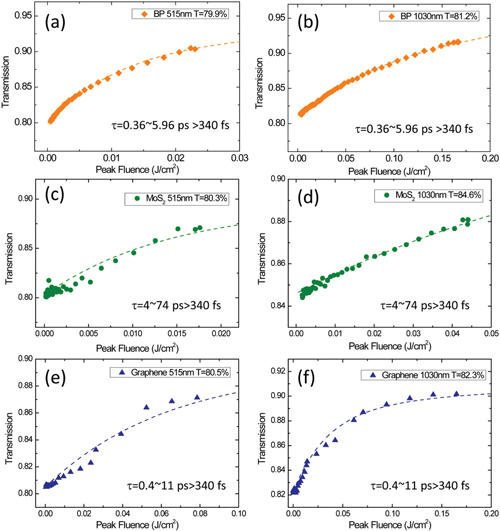As an emerging two-dimensional layered material, black phosphorus (BP) has shown superior optical features (saturable absorption performance) over its counterparts like the family of transition metal dichalcogenides (MoS2, WS2, etc.) and graphene. This implies significant potential application in Q-switching and mode-locking devices.
Although BP has been widely used as a superior saturable absorber in Q-switching and mode-locking, the reason why the saturable absorption performance of BP is superior over graphene, namely, why the saturable intensity of BP is much lower than graphene, is still to be explored.
Scientists have demonstrated that excited-state absorption (ESA) exists in BP nanosheets using a two color pump–probe spectroscopy technique. This implies that the ESA and ground-state absorption (GSA) may play an important role in the nonlinear absorption process of BP and need to be taken into account.
Researchers at Shanghai Institute of Optics and Fines Mechanics (SIOM) of Chinese Academy of Sciences (CAS) through experiments found that for BP, the critical parameter of saturable material is the smallest. This means that the ground-state transition probability of BP is relatively large and the excited-state transition probability is small, resulting in good state-filling in the momentum space of the conduction band due to the Pauli Exclusion Principle. This can well explain the superior saturable absorption property of BP in the VIS to near-infrared (NIR) range. The study was published in Nanoscale.
(http://pubs.rsc.org/en/Content/ArticleLanding/2016/NR/C6NR06076E#!divAbstract)
Experiments have obtained the GSA and ESA cross sections σgs and σes of BP nanosheets, (1.25 ± 0.07) × 10−16 cm2 and (2.97 ± 0.21) × 10−17 cm2 at 515 nm, and (5.95 ± 0.17) ×10−18 cm2 and (5.19 ± 0.71) × 10−19 cm2 at 1030 nm with the slow SA model. The ratio of σes /σgs is about 0.24 ± 0.03 at 515 nm and 0.09 ± 0.01 at 1030 nm. It is even lower when the fast SA model is applied. The σgs and σes of MoS2 and graphene were also achieved using the slow SA model. It is clear that the ratio σes /σgs of BP is the smallest among the three two-dimensional layered materials.
The results fundamentally support BP to be used as a saturable absorber in nanophotonic devices, such as fiber laser mode-locking, Q-switching, optical switches, etc.
This work was partially supported by NSFC, the External Cooperation Program of BIC, CAS, the Key Research Program of Frontier Science of CAS, and the Strategic Priority Research Program of CAS. J. N. C. acknowledges the European Research Council (SEMANTICS), SFI (11/PI/1087), SFI funded centre AMBER (SFI/12/RC/2278), EU FP7 grant no.604391 Graphene Flagship for financial support.

Fig. Nonlinear fitting with slow saturable absorber model for (a, b) BP, (c, d) MoS2 and (e, f ) graphene at 515 nm and 1030 nm.(Image by Zhang Saifeng )
Contact:
Saifeng Zhang
Shanghai Institute of Optics and Fine Mechanics
E-mail: sfzhang@siom.ac.cn







